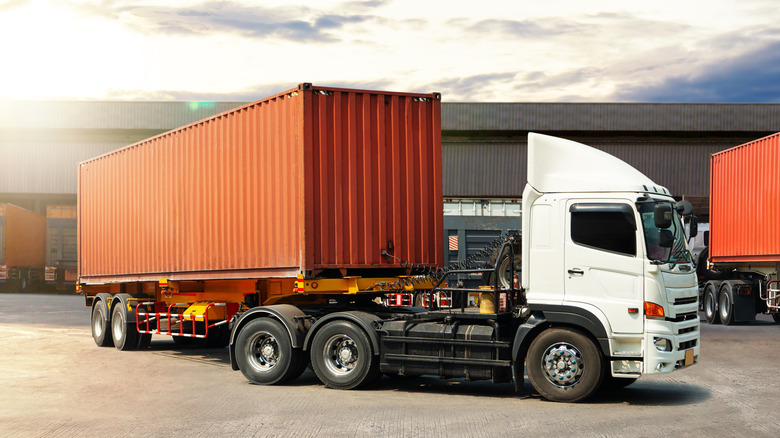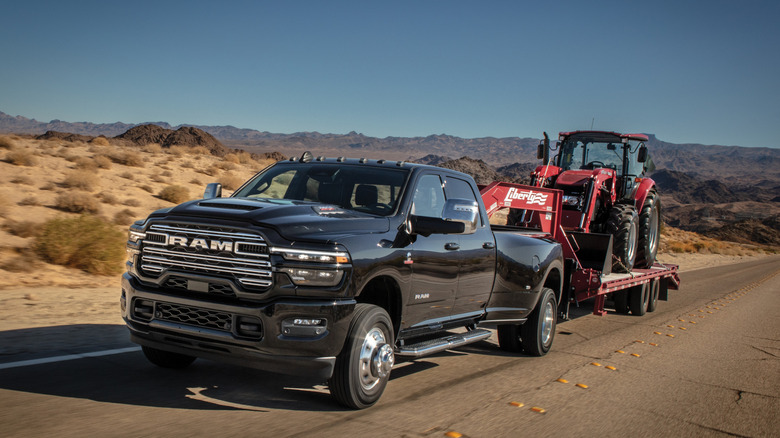What Is The Biggest Trailer You Can Tow Without A CDL License?
Semi trucks are still responsible for transporting much of what we rely on every single day, from food through to fuel. The chances are, every time you hop onto the highway, that you'll see at least a handful of them crawling along with full trailers. For each semi truck you see, at the helm is a trucker who's qualified to be there. The qualification in question is a CDL – or Commercial Driver's License.
A CDL is required in order for someone to drive a larger vehicle with a huge payload, but at what point does one become necessary? The simple rule is that federal law requires you to have a CDL when the Gross Vehicle Weight Rating (GVWR) of the vehicle exceeds 26,000 pounds. This is the maximum weight which your vehicle can carry, and it includes everything, from the vehicle to the tongue weight, gas, occupants, cargo — everything — just not the trailer and its contents. You can find the GVWR of your vehicle on the spec sticker, which is typically located on the inside of the driver's door. For reference, a Class 6 truck will have a GVWR of between 19,001 and 26,000 pounds, so is exempt from requiring a CDL to drive (until the addition of a trailer, as this could cause the GCWR to push it into CDL territory, which we explain further down), whereas a loaded Class 7 or 8 truck will require a CDL, as these sport GVWRs of up to 33,000 pounds and beyond. The exact maximum size of a trailer you can tow without a CDL does vary, according to the GVWR and GCWR.
It's important to know the difference between GCWR and GVWR
The rules also apply if the Gross Combined Weight Rating (GCWR) exceeds 26,000 pounds and the trailer's Gross Vehicle Weight Rating (GVWR) is 10,000 pounds or more. It's important you know both of these figures for your truck, as towing over capacity is easily done and can be dangerous to both you and your truck. GCWR differs from GVWR as it also includes the weight of the trailer and its contents. For example, the GVWR of a base 2021 Ford F-150 is 6,010 pounds, whereas Ford lists the GCWR as 9,400 pounds. The most capable 2021 F-150 trim, a 3.5L EcoBoost V6-powered Supercrew model, sports a GCWR of 19,500 pounds and a GVWR of 7,350 pounds. This means that, even when fully loaded, the Ford can tow a trailer that weighs 12,150 pounds. In this instance, the GCWR of both the F-150 and the trailer does not exceed 26,000 pounds, and so a CDL is not required.
However, if instead of an F-150, you find yourself behind the wheel of a 2023 Ram 3500 HD with a 6.7L Cummins high-output diesel engine, then the circumstances are different. This heavy-duty pickup sports a GCWR of 43,000 pounds, and a GVWR of 13,500 pounds. Let's assume the vehicle is running at its maximum GVWR of 13,500 pounds, but the trailer only tips the scales at 11,000 pounds. Here, the combined weight is under the 26,000-pound threshold, so no CDL is required. However, add another 2,000 pounds to that trailer, and the GCWR becomes 26,500 pounds — at this point, a CDL is required, as not only does the GCWR exceed 26,000 pounds, but the trailer's GVWR is also over and above 10,000 pounds.
How to obtain a CDL
There are other circumstances beyond weight in which a CDL would also be required, regardless of the vehicle's GVWR or GCWR. For instance, if the driver is transporting hazardous materials, or 16 or more occupants (themselves included), then federal law states a CDL must also be obtained.
Fortunately, getting hold of a CDL is straightforward. The technicalities may vary from state to state, but generally, the rules are fairly uniform across the US. First, the applicant must get hold of a learner's permit, before then going through driving school, and passing a driving test at the end. Obtaining a commercial driver's learning permit requires passing a prior knowledge test, in addition to being medically fit and boasting a clean driving record. The final CDL test will consist of three parts, which are a vehicle inspection test, basic controls test, and road test – all must be passed in order for the CDL to be granted. The cost of this process can vary wildly, with most professionals suggesting between $4,000 and $12,000 in order to obtain the license from start to finish.
It's worth noting that certain restrictions can be placed upon a driver's CDL. For example, if a driver passes the appropriate tests in an automatic truck, then an E restriction code will be applied to the license, which means they are not permitted to drive manual-transmission trucks.


